Valuation Methods: Historical Cost versus Fair Value Accounting
VerifiedAdded on 2020/05/16
|15
|2456
|72
Report
AI Summary
This report provides a comprehensive analysis of historical cost and fair value accounting methods, focusing on their application to non-financial assets like intangible assets and plant, property, and equipment (PPE). The report evaluates the benefits and challenges of each method, supported by a literature review and analysis of valuation practices across three companies: Rio Tinto, Acacia Mining plc, and Yamana Gold Plc. The report examines the valuation policies of these companies, analyzes the consistency of their practices, and offers an opinion on the free choice between historical cost and fair value accounting, considering both management and investor perspectives. The conclusion summarizes the findings, highlighting the ongoing debate surrounding valuation methods and the importance of improved information quality and disclosure for accurate financial reporting. The report emphasizes the need for organizations to take appropriate measures to improve information quality, including additional disclosure requirements and addressing factors that influence fair value accounting.
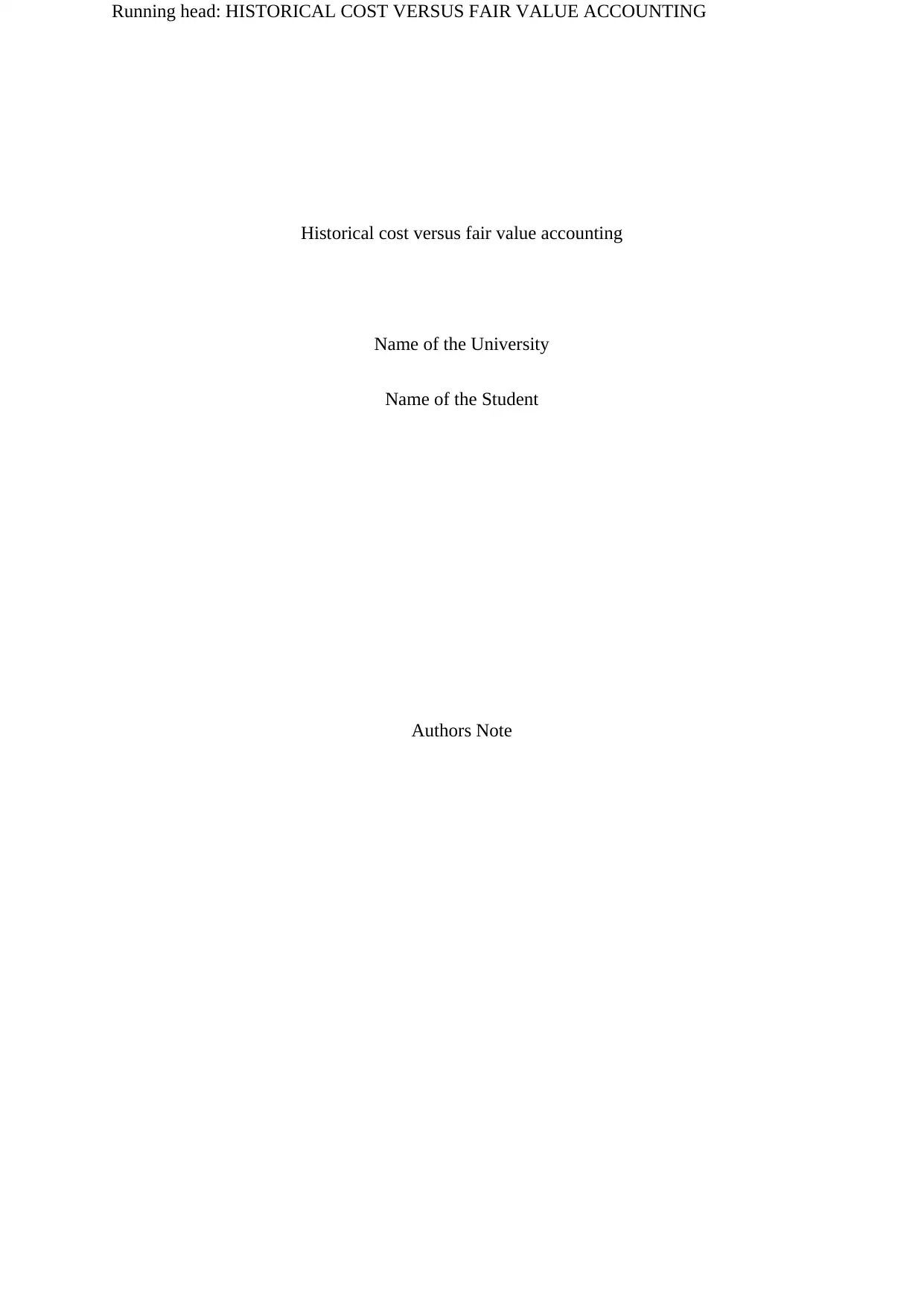
Running head: HISTORICAL COST VERSUS FAIR VALUE ACCOUNTING
Historical cost versus fair value accounting
Name of the University
Name of the Student
Authors Note
Historical cost versus fair value accounting
Name of the University
Name of the Student
Authors Note
Paraphrase This Document
Need a fresh take? Get an instant paraphrase of this document with our AI Paraphraser
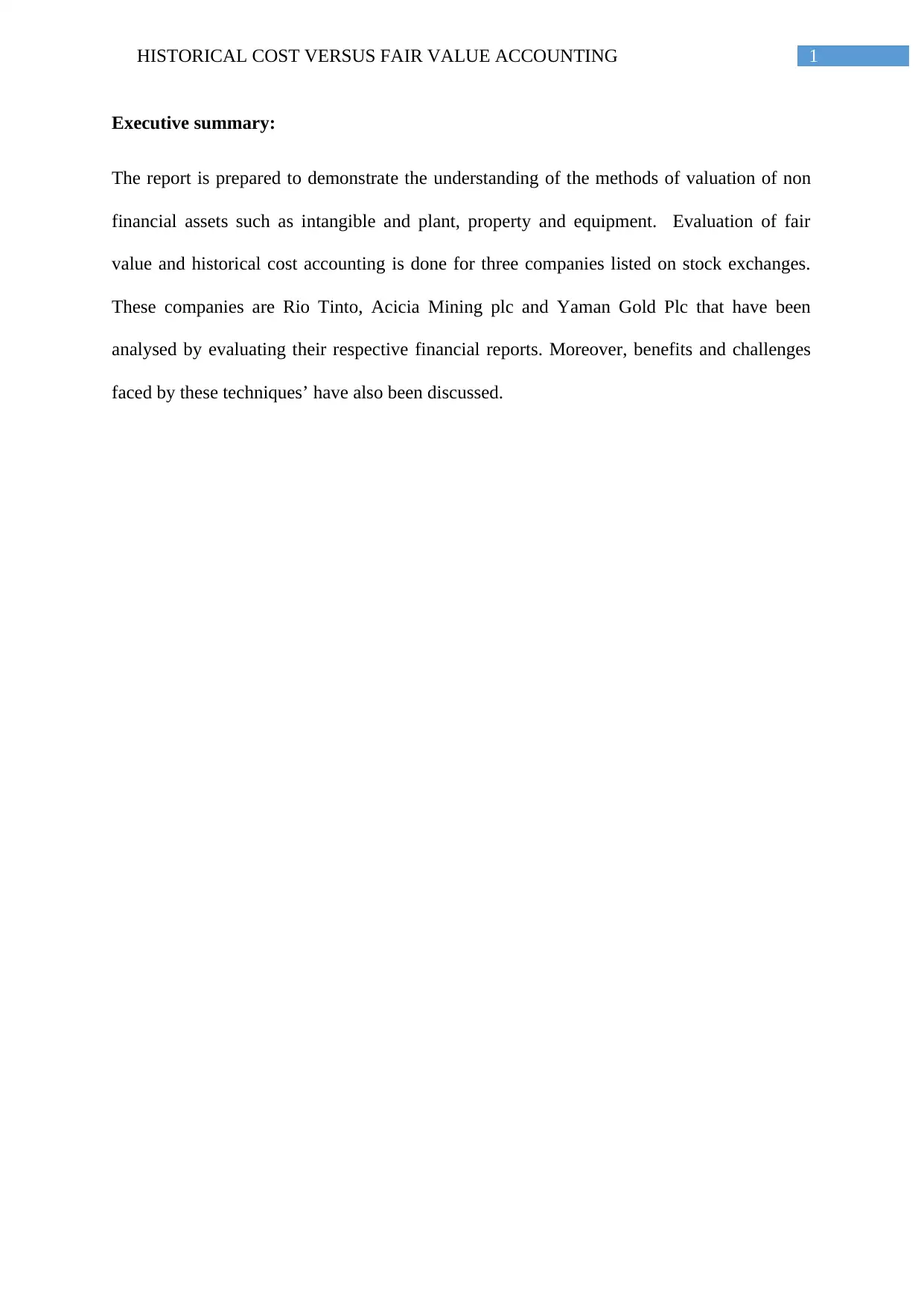
1HISTORICAL COST VERSUS FAIR VALUE ACCOUNTING
Executive summary:
The report is prepared to demonstrate the understanding of the methods of valuation of non
financial assets such as intangible and plant, property and equipment. Evaluation of fair
value and historical cost accounting is done for three companies listed on stock exchanges.
These companies are Rio Tinto, Acicia Mining plc and Yaman Gold Plc that have been
analysed by evaluating their respective financial reports. Moreover, benefits and challenges
faced by these techniques’ have also been discussed.
Executive summary:
The report is prepared to demonstrate the understanding of the methods of valuation of non
financial assets such as intangible and plant, property and equipment. Evaluation of fair
value and historical cost accounting is done for three companies listed on stock exchanges.
These companies are Rio Tinto, Acicia Mining plc and Yaman Gold Plc that have been
analysed by evaluating their respective financial reports. Moreover, benefits and challenges
faced by these techniques’ have also been discussed.
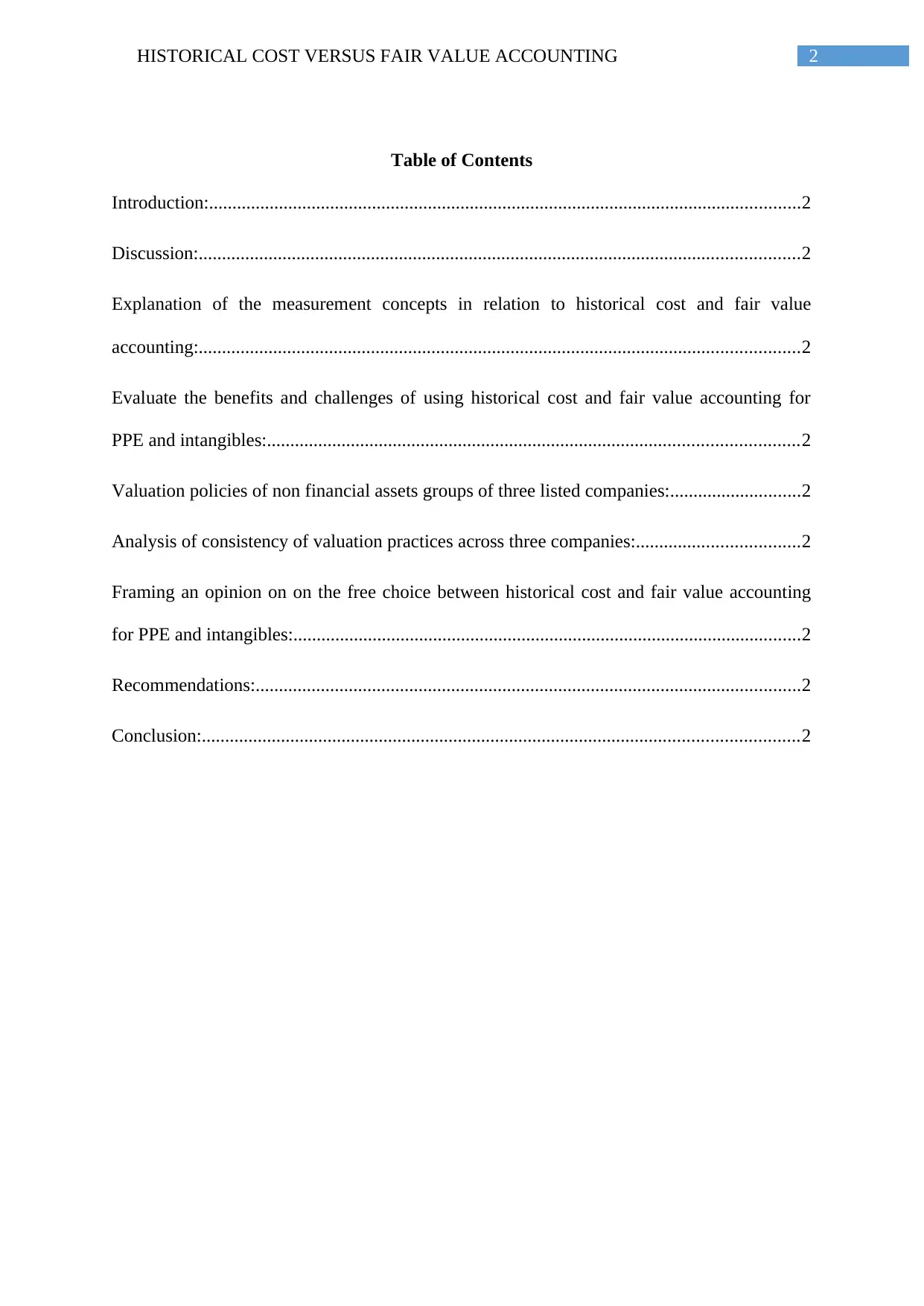
2HISTORICAL COST VERSUS FAIR VALUE ACCOUNTING
Table of Contents
Introduction:...............................................................................................................................2
Discussion:.................................................................................................................................2
Explanation of the measurement concepts in relation to historical cost and fair value
accounting:.................................................................................................................................2
Evaluate the benefits and challenges of using historical cost and fair value accounting for
PPE and intangibles:..................................................................................................................2
Valuation policies of non financial assets groups of three listed companies:............................2
Analysis of consistency of valuation practices across three companies:...................................2
Framing an opinion on on the free choice between historical cost and fair value accounting
for PPE and intangibles:.............................................................................................................2
Recommendations:.....................................................................................................................2
Conclusion:................................................................................................................................2
Table of Contents
Introduction:...............................................................................................................................2
Discussion:.................................................................................................................................2
Explanation of the measurement concepts in relation to historical cost and fair value
accounting:.................................................................................................................................2
Evaluate the benefits and challenges of using historical cost and fair value accounting for
PPE and intangibles:..................................................................................................................2
Valuation policies of non financial assets groups of three listed companies:............................2
Analysis of consistency of valuation practices across three companies:...................................2
Framing an opinion on on the free choice between historical cost and fair value accounting
for PPE and intangibles:.............................................................................................................2
Recommendations:.....................................................................................................................2
Conclusion:................................................................................................................................2
⊘ This is a preview!⊘
Do you want full access?
Subscribe today to unlock all pages.

Trusted by 1+ million students worldwide
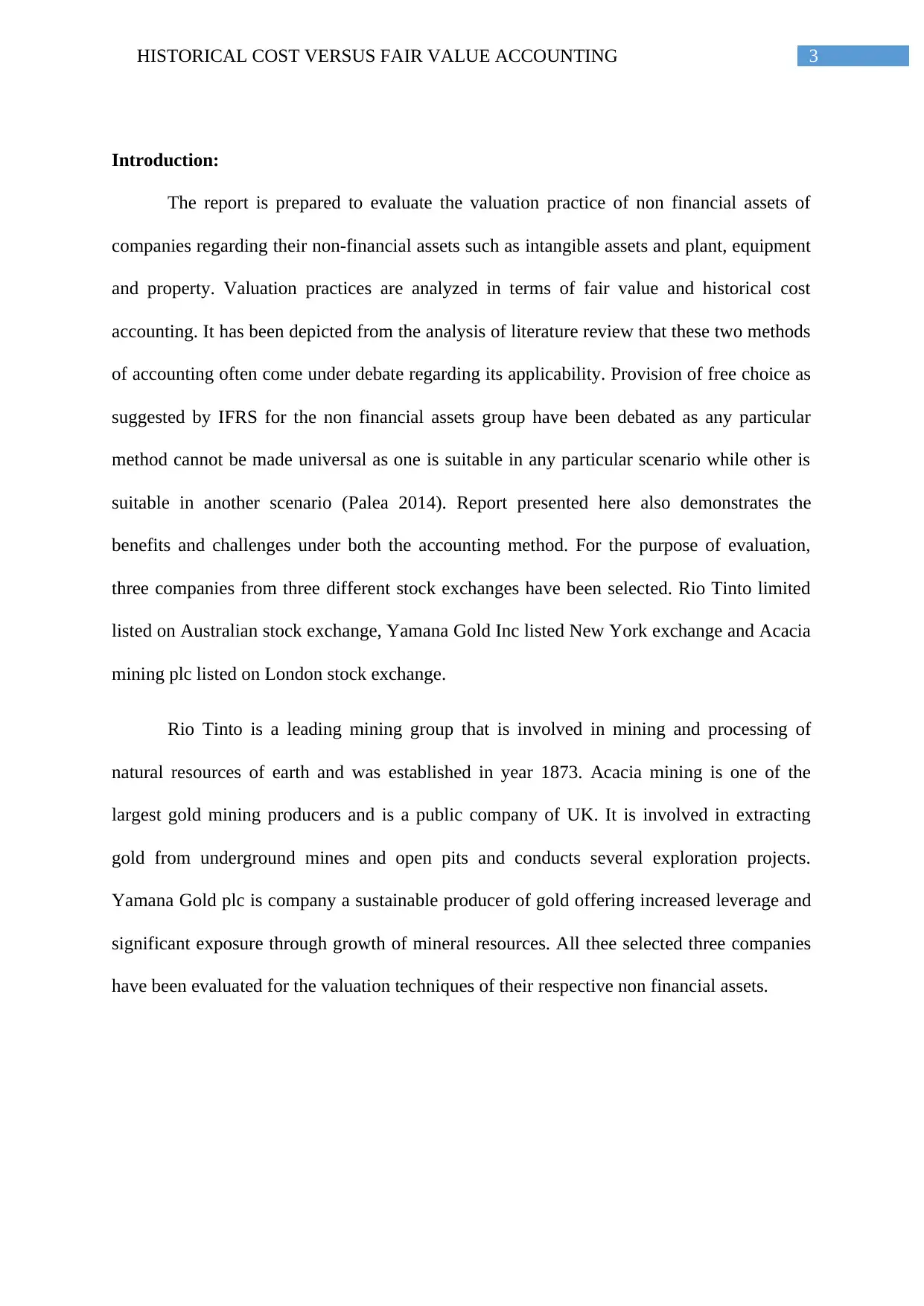
3HISTORICAL COST VERSUS FAIR VALUE ACCOUNTING
Introduction:
The report is prepared to evaluate the valuation practice of non financial assets of
companies regarding their non-financial assets such as intangible assets and plant, equipment
and property. Valuation practices are analyzed in terms of fair value and historical cost
accounting. It has been depicted from the analysis of literature review that these two methods
of accounting often come under debate regarding its applicability. Provision of free choice as
suggested by IFRS for the non financial assets group have been debated as any particular
method cannot be made universal as one is suitable in any particular scenario while other is
suitable in another scenario (Palea 2014). Report presented here also demonstrates the
benefits and challenges under both the accounting method. For the purpose of evaluation,
three companies from three different stock exchanges have been selected. Rio Tinto limited
listed on Australian stock exchange, Yamana Gold Inc listed New York exchange and Acacia
mining plc listed on London stock exchange.
Rio Tinto is a leading mining group that is involved in mining and processing of
natural resources of earth and was established in year 1873. Acacia mining is one of the
largest gold mining producers and is a public company of UK. It is involved in extracting
gold from underground mines and open pits and conducts several exploration projects.
Yamana Gold plc is company a sustainable producer of gold offering increased leverage and
significant exposure through growth of mineral resources. All thee selected three companies
have been evaluated for the valuation techniques of their respective non financial assets.
Introduction:
The report is prepared to evaluate the valuation practice of non financial assets of
companies regarding their non-financial assets such as intangible assets and plant, equipment
and property. Valuation practices are analyzed in terms of fair value and historical cost
accounting. It has been depicted from the analysis of literature review that these two methods
of accounting often come under debate regarding its applicability. Provision of free choice as
suggested by IFRS for the non financial assets group have been debated as any particular
method cannot be made universal as one is suitable in any particular scenario while other is
suitable in another scenario (Palea 2014). Report presented here also demonstrates the
benefits and challenges under both the accounting method. For the purpose of evaluation,
three companies from three different stock exchanges have been selected. Rio Tinto limited
listed on Australian stock exchange, Yamana Gold Inc listed New York exchange and Acacia
mining plc listed on London stock exchange.
Rio Tinto is a leading mining group that is involved in mining and processing of
natural resources of earth and was established in year 1873. Acacia mining is one of the
largest gold mining producers and is a public company of UK. It is involved in extracting
gold from underground mines and open pits and conducts several exploration projects.
Yamana Gold plc is company a sustainable producer of gold offering increased leverage and
significant exposure through growth of mineral resources. All thee selected three companies
have been evaluated for the valuation techniques of their respective non financial assets.
Paraphrase This Document
Need a fresh take? Get an instant paraphrase of this document with our AI Paraphraser
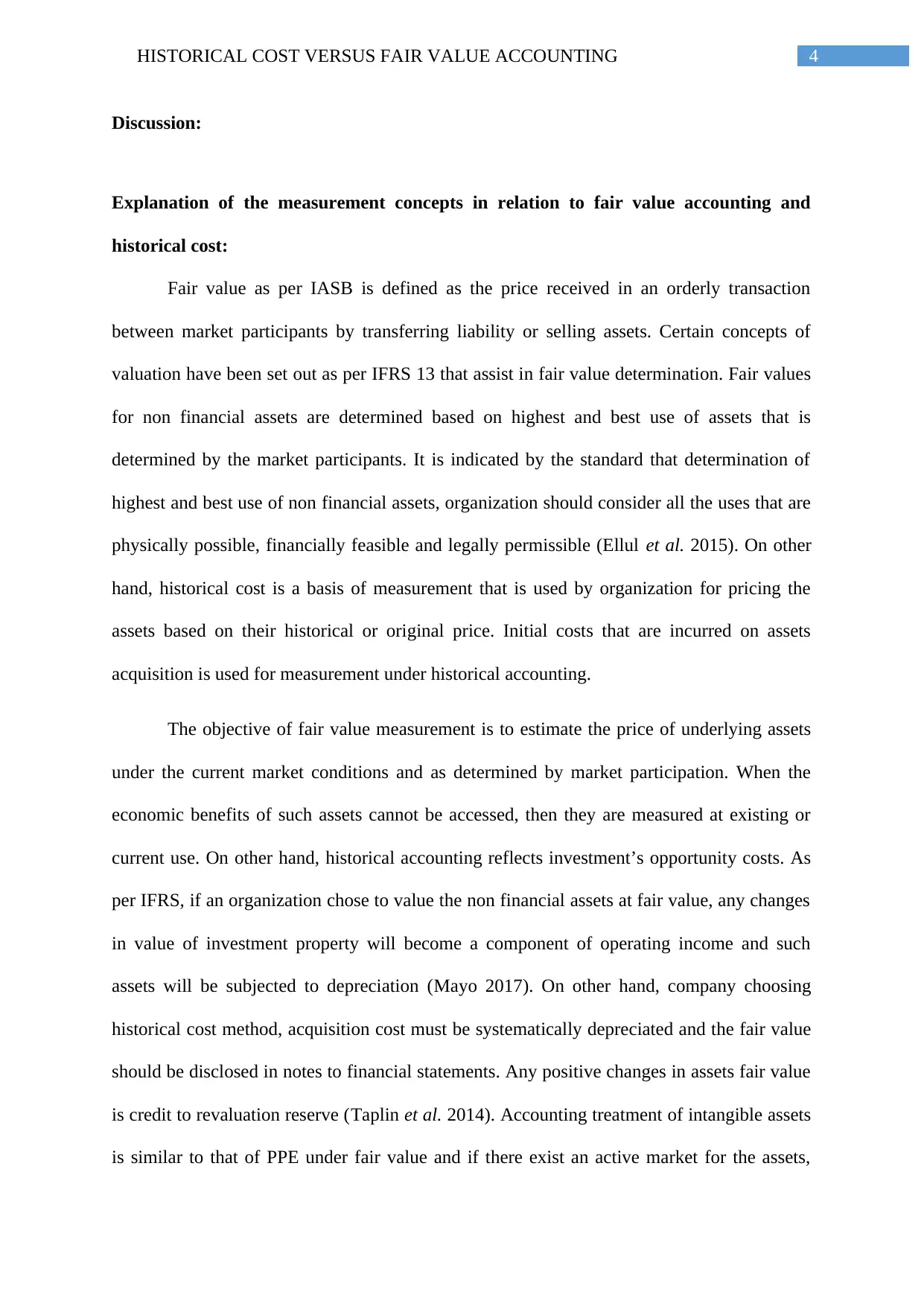
4HISTORICAL COST VERSUS FAIR VALUE ACCOUNTING
Discussion:
Explanation of the measurement concepts in relation to fair value accounting and
historical cost:
Fair value as per IASB is defined as the price received in an orderly transaction
between market participants by transferring liability or selling assets. Certain concepts of
valuation have been set out as per IFRS 13 that assist in fair value determination. Fair values
for non financial assets are determined based on highest and best use of assets that is
determined by the market participants. It is indicated by the standard that determination of
highest and best use of non financial assets, organization should consider all the uses that are
physically possible, financially feasible and legally permissible (Ellul et al. 2015). On other
hand, historical cost is a basis of measurement that is used by organization for pricing the
assets based on their historical or original price. Initial costs that are incurred on assets
acquisition is used for measurement under historical accounting.
The objective of fair value measurement is to estimate the price of underlying assets
under the current market conditions and as determined by market participation. When the
economic benefits of such assets cannot be accessed, then they are measured at existing or
current use. On other hand, historical accounting reflects investment’s opportunity costs. As
per IFRS, if an organization chose to value the non financial assets at fair value, any changes
in value of investment property will become a component of operating income and such
assets will be subjected to depreciation (Mayo 2017). On other hand, company choosing
historical cost method, acquisition cost must be systematically depreciated and the fair value
should be disclosed in notes to financial statements. Any positive changes in assets fair value
is credit to revaluation reserve (Taplin et al. 2014). Accounting treatment of intangible assets
is similar to that of PPE under fair value and if there exist an active market for the assets,
Discussion:
Explanation of the measurement concepts in relation to fair value accounting and
historical cost:
Fair value as per IASB is defined as the price received in an orderly transaction
between market participants by transferring liability or selling assets. Certain concepts of
valuation have been set out as per IFRS 13 that assist in fair value determination. Fair values
for non financial assets are determined based on highest and best use of assets that is
determined by the market participants. It is indicated by the standard that determination of
highest and best use of non financial assets, organization should consider all the uses that are
physically possible, financially feasible and legally permissible (Ellul et al. 2015). On other
hand, historical cost is a basis of measurement that is used by organization for pricing the
assets based on their historical or original price. Initial costs that are incurred on assets
acquisition is used for measurement under historical accounting.
The objective of fair value measurement is to estimate the price of underlying assets
under the current market conditions and as determined by market participation. When the
economic benefits of such assets cannot be accessed, then they are measured at existing or
current use. On other hand, historical accounting reflects investment’s opportunity costs. As
per IFRS, if an organization chose to value the non financial assets at fair value, any changes
in value of investment property will become a component of operating income and such
assets will be subjected to depreciation (Mayo 2017). On other hand, company choosing
historical cost method, acquisition cost must be systematically depreciated and the fair value
should be disclosed in notes to financial statements. Any positive changes in assets fair value
is credit to revaluation reserve (Taplin et al. 2014). Accounting treatment of intangible assets
is similar to that of PPE under fair value and if there exist an active market for the assets,
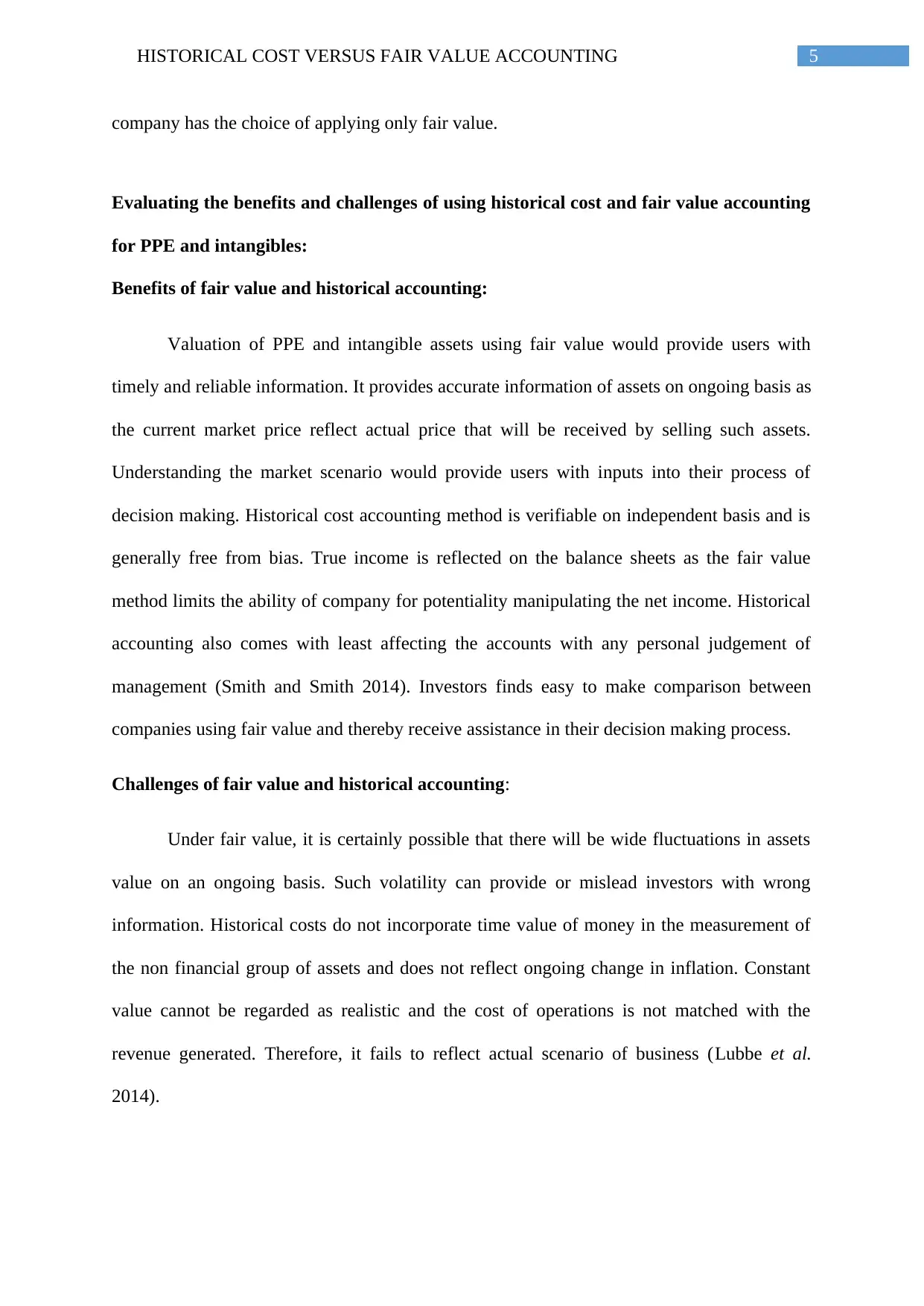
5HISTORICAL COST VERSUS FAIR VALUE ACCOUNTING
company has the choice of applying only fair value.
Evaluating the benefits and challenges of using historical cost and fair value accounting
for PPE and intangibles:
Benefits of fair value and historical accounting:
Valuation of PPE and intangible assets using fair value would provide users with
timely and reliable information. It provides accurate information of assets on ongoing basis as
the current market price reflect actual price that will be received by selling such assets.
Understanding the market scenario would provide users with inputs into their process of
decision making. Historical cost accounting method is verifiable on independent basis and is
generally free from bias. True income is reflected on the balance sheets as the fair value
method limits the ability of company for potentiality manipulating the net income. Historical
accounting also comes with least affecting the accounts with any personal judgement of
management (Smith and Smith 2014). Investors finds easy to make comparison between
companies using fair value and thereby receive assistance in their decision making process.
Challenges of fair value and historical accounting:
Under fair value, it is certainly possible that there will be wide fluctuations in assets
value on an ongoing basis. Such volatility can provide or mislead investors with wrong
information. Historical costs do not incorporate time value of money in the measurement of
the non financial group of assets and does not reflect ongoing change in inflation. Constant
value cannot be regarded as realistic and the cost of operations is not matched with the
revenue generated. Therefore, it fails to reflect actual scenario of business (Lubbe et al.
2014).
company has the choice of applying only fair value.
Evaluating the benefits and challenges of using historical cost and fair value accounting
for PPE and intangibles:
Benefits of fair value and historical accounting:
Valuation of PPE and intangible assets using fair value would provide users with
timely and reliable information. It provides accurate information of assets on ongoing basis as
the current market price reflect actual price that will be received by selling such assets.
Understanding the market scenario would provide users with inputs into their process of
decision making. Historical cost accounting method is verifiable on independent basis and is
generally free from bias. True income is reflected on the balance sheets as the fair value
method limits the ability of company for potentiality manipulating the net income. Historical
accounting also comes with least affecting the accounts with any personal judgement of
management (Smith and Smith 2014). Investors finds easy to make comparison between
companies using fair value and thereby receive assistance in their decision making process.
Challenges of fair value and historical accounting:
Under fair value, it is certainly possible that there will be wide fluctuations in assets
value on an ongoing basis. Such volatility can provide or mislead investors with wrong
information. Historical costs do not incorporate time value of money in the measurement of
the non financial group of assets and does not reflect ongoing change in inflation. Constant
value cannot be regarded as realistic and the cost of operations is not matched with the
revenue generated. Therefore, it fails to reflect actual scenario of business (Lubbe et al.
2014).
⊘ This is a preview!⊘
Do you want full access?
Subscribe today to unlock all pages.

Trusted by 1+ million students worldwide
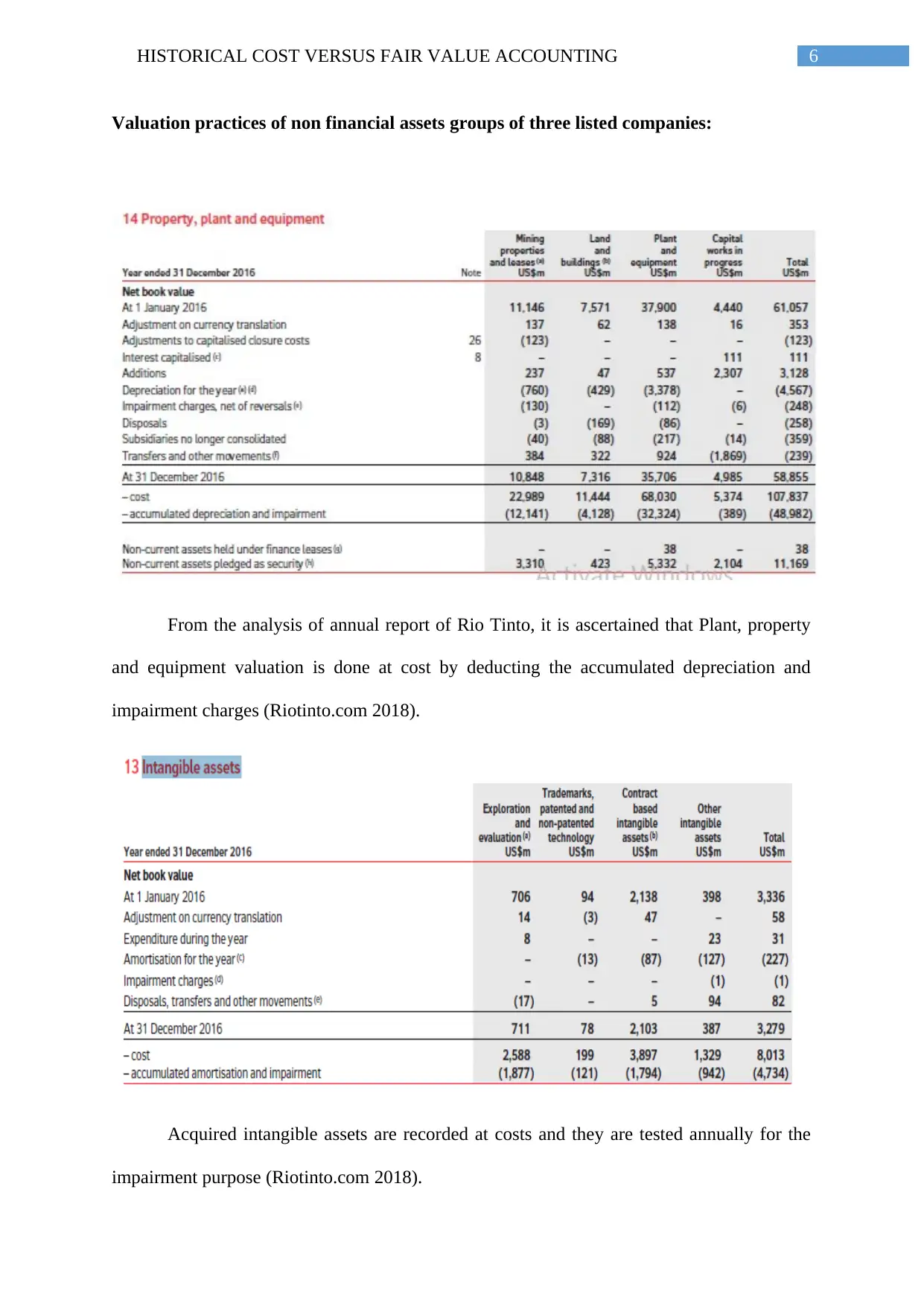
6HISTORICAL COST VERSUS FAIR VALUE ACCOUNTING
Valuation practices of non financial assets groups of three listed companies:
From the analysis of annual report of Rio Tinto, it is ascertained that Plant, property
and equipment valuation is done at cost by deducting the accumulated depreciation and
impairment charges (Riotinto.com 2018).
Acquired intangible assets are recorded at costs and they are tested annually for the
impairment purpose (Riotinto.com 2018).
Valuation practices of non financial assets groups of three listed companies:
From the analysis of annual report of Rio Tinto, it is ascertained that Plant, property
and equipment valuation is done at cost by deducting the accumulated depreciation and
impairment charges (Riotinto.com 2018).
Acquired intangible assets are recorded at costs and they are tested annually for the
impairment purpose (Riotinto.com 2018).
Paraphrase This Document
Need a fresh take? Get an instant paraphrase of this document with our AI Paraphraser
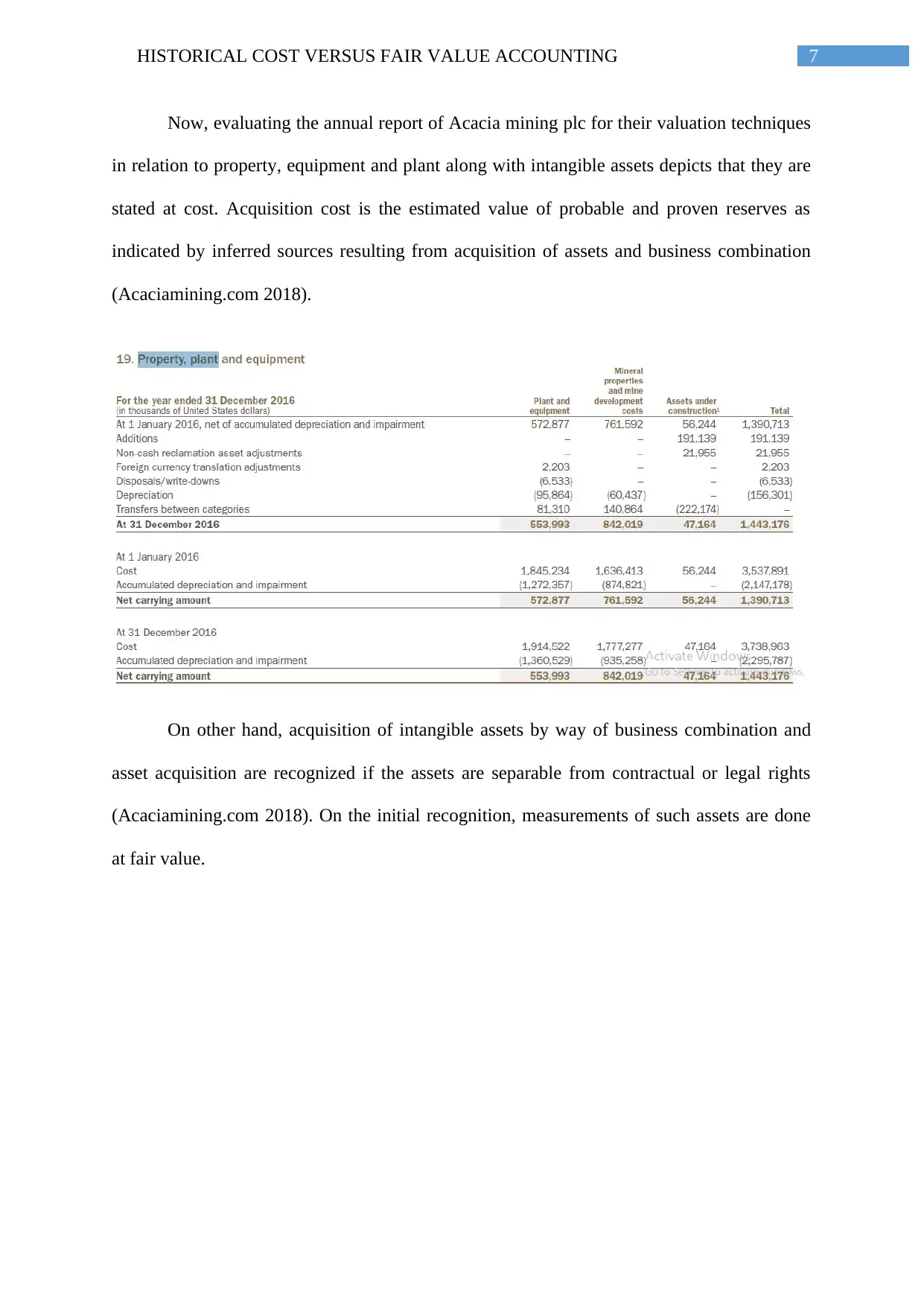
7HISTORICAL COST VERSUS FAIR VALUE ACCOUNTING
Now, evaluating the annual report of Acacia mining plc for their valuation techniques
in relation to property, equipment and plant along with intangible assets depicts that they are
stated at cost. Acquisition cost is the estimated value of probable and proven reserves as
indicated by inferred sources resulting from acquisition of assets and business combination
(Acaciamining.com 2018).
On other hand, acquisition of intangible assets by way of business combination and
asset acquisition are recognized if the assets are separable from contractual or legal rights
(Acaciamining.com 2018). On the initial recognition, measurements of such assets are done
at fair value.
Now, evaluating the annual report of Acacia mining plc for their valuation techniques
in relation to property, equipment and plant along with intangible assets depicts that they are
stated at cost. Acquisition cost is the estimated value of probable and proven reserves as
indicated by inferred sources resulting from acquisition of assets and business combination
(Acaciamining.com 2018).
On other hand, acquisition of intangible assets by way of business combination and
asset acquisition are recognized if the assets are separable from contractual or legal rights
(Acaciamining.com 2018). On the initial recognition, measurements of such assets are done
at fair value.
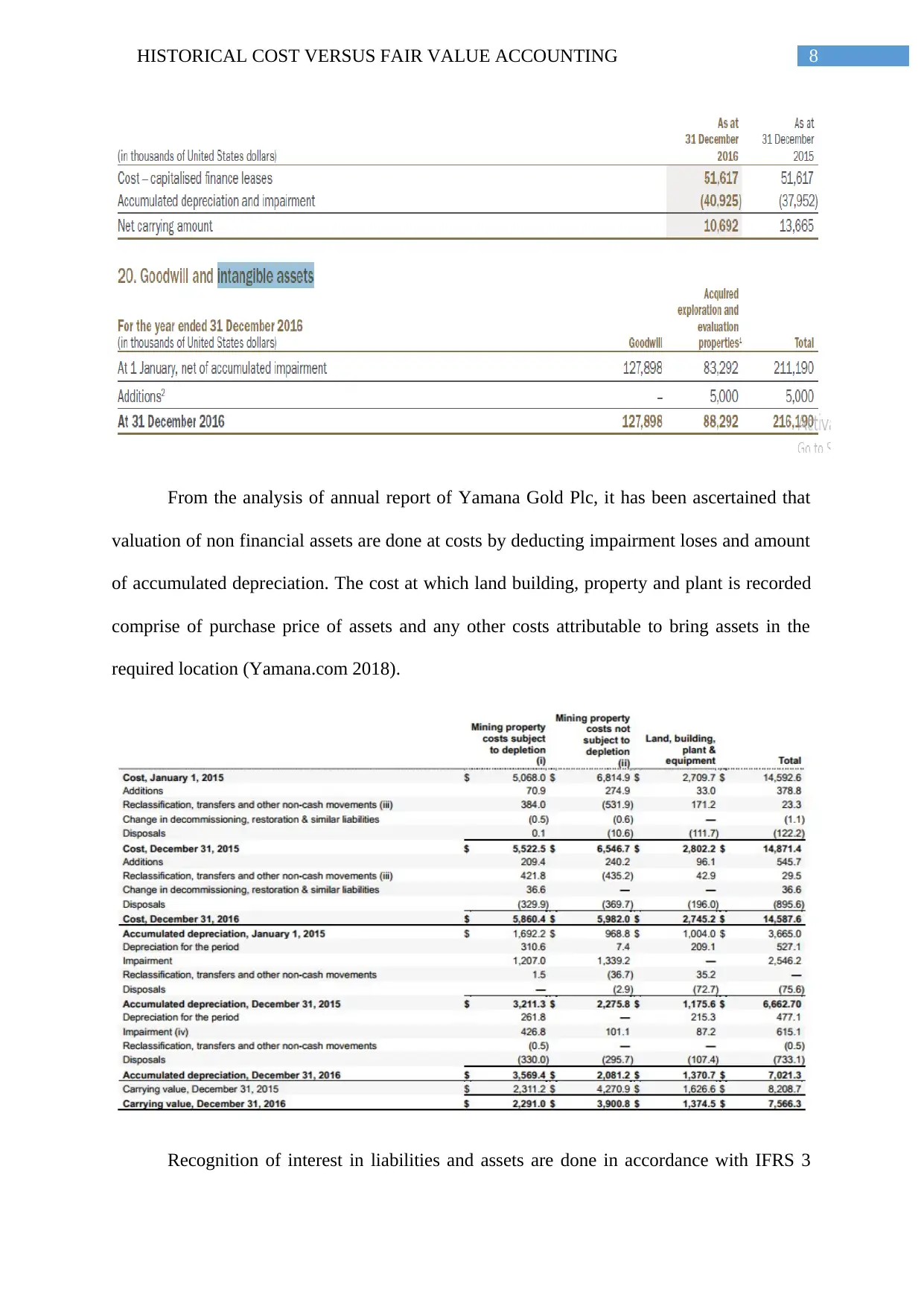
8HISTORICAL COST VERSUS FAIR VALUE ACCOUNTING
From the analysis of annual report of Yamana Gold Plc, it has been ascertained that
valuation of non financial assets are done at costs by deducting impairment loses and amount
of accumulated depreciation. The cost at which land building, property and plant is recorded
comprise of purchase price of assets and any other costs attributable to bring assets in the
required location (Yamana.com 2018).
Recognition of interest in liabilities and assets are done in accordance with IFRS 3
From the analysis of annual report of Yamana Gold Plc, it has been ascertained that
valuation of non financial assets are done at costs by deducting impairment loses and amount
of accumulated depreciation. The cost at which land building, property and plant is recorded
comprise of purchase price of assets and any other costs attributable to bring assets in the
required location (Yamana.com 2018).
Recognition of interest in liabilities and assets are done in accordance with IFRS 3
⊘ This is a preview!⊘
Do you want full access?
Subscribe today to unlock all pages.

Trusted by 1+ million students worldwide
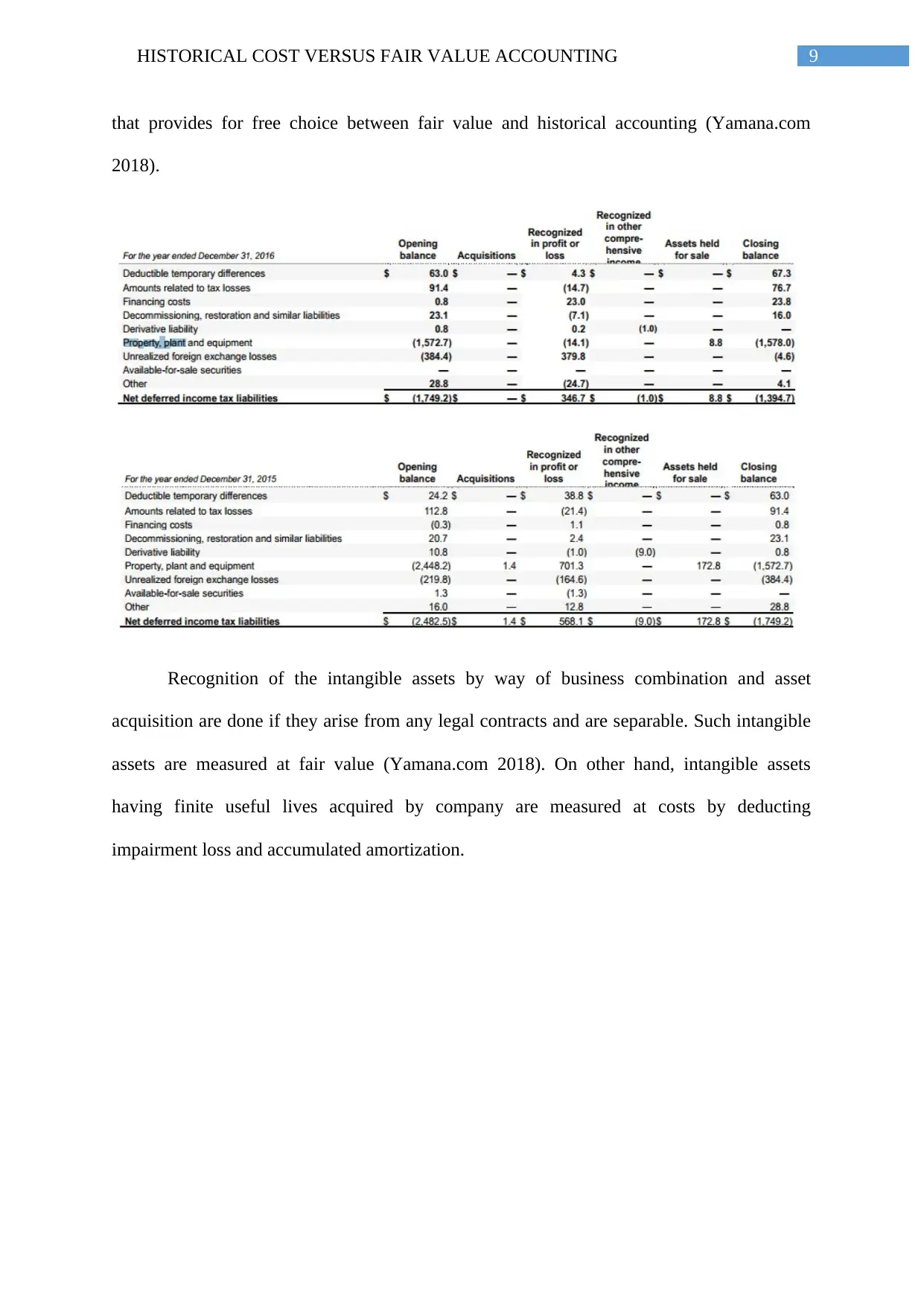
9HISTORICAL COST VERSUS FAIR VALUE ACCOUNTING
that provides for free choice between fair value and historical accounting (Yamana.com
2018).
Recognition of the intangible assets by way of business combination and asset
acquisition are done if they arise from any legal contracts and are separable. Such intangible
assets are measured at fair value (Yamana.com 2018). On other hand, intangible assets
having finite useful lives acquired by company are measured at costs by deducting
impairment loss and accumulated amortization.
that provides for free choice between fair value and historical accounting (Yamana.com
2018).
Recognition of the intangible assets by way of business combination and asset
acquisition are done if they arise from any legal contracts and are separable. Such intangible
assets are measured at fair value (Yamana.com 2018). On other hand, intangible assets
having finite useful lives acquired by company are measured at costs by deducting
impairment loss and accumulated amortization.
Paraphrase This Document
Need a fresh take? Get an instant paraphrase of this document with our AI Paraphraser
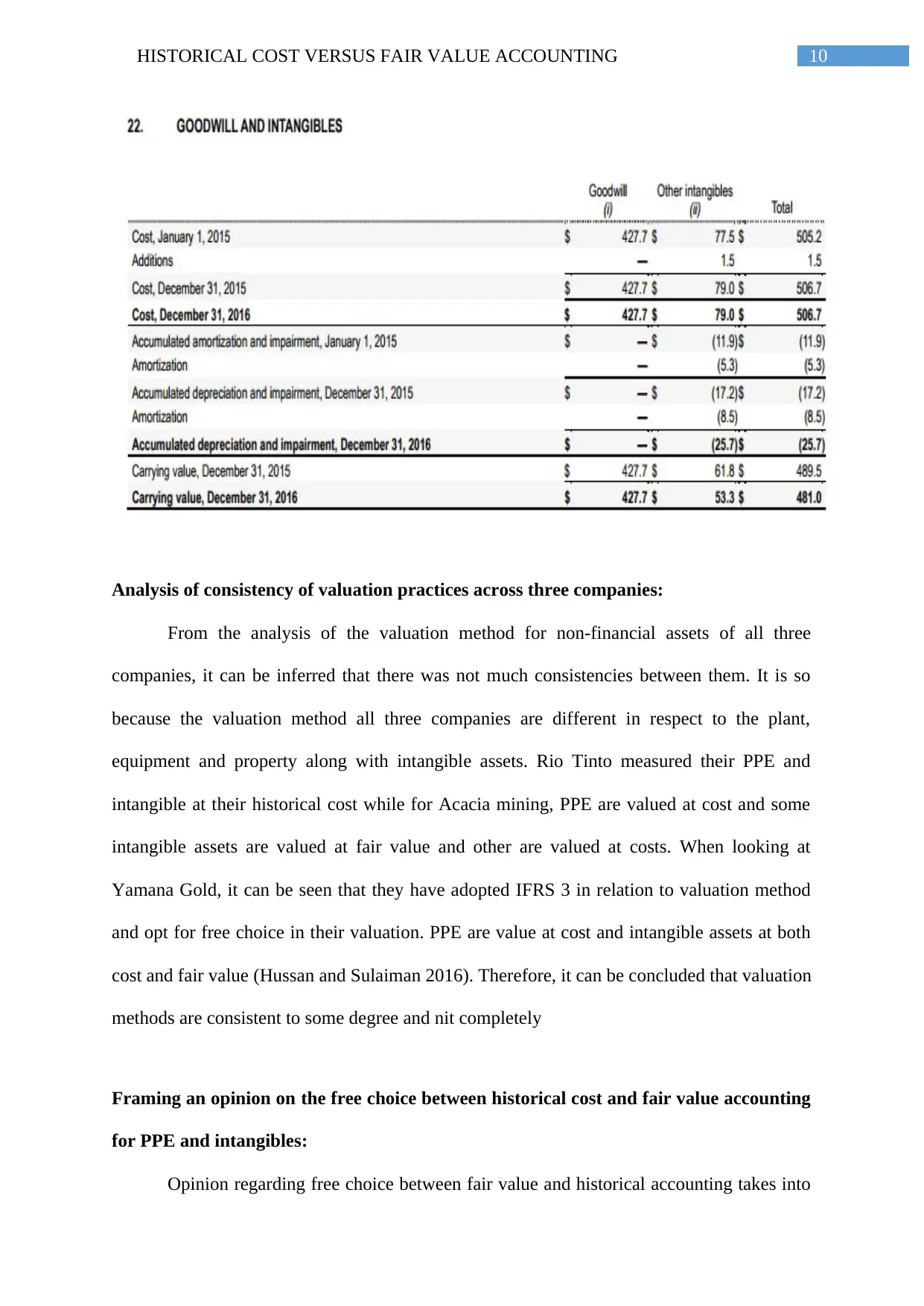
10HISTORICAL COST VERSUS FAIR VALUE ACCOUNTING
Analysis of consistency of valuation practices across three companies:
From the analysis of the valuation method for non-financial assets of all three
companies, it can be inferred that there was not much consistencies between them. It is so
because the valuation method all three companies are different in respect to the plant,
equipment and property along with intangible assets. Rio Tinto measured their PPE and
intangible at their historical cost while for Acacia mining, PPE are valued at cost and some
intangible assets are valued at fair value and other are valued at costs. When looking at
Yamana Gold, it can be seen that they have adopted IFRS 3 in relation to valuation method
and opt for free choice in their valuation. PPE are value at cost and intangible assets at both
cost and fair value (Hussan and Sulaiman 2016). Therefore, it can be concluded that valuation
methods are consistent to some degree and nit completely
Framing an opinion on the free choice between historical cost and fair value accounting
for PPE and intangibles:
Opinion regarding free choice between fair value and historical accounting takes into
Analysis of consistency of valuation practices across three companies:
From the analysis of the valuation method for non-financial assets of all three
companies, it can be inferred that there was not much consistencies between them. It is so
because the valuation method all three companies are different in respect to the plant,
equipment and property along with intangible assets. Rio Tinto measured their PPE and
intangible at their historical cost while for Acacia mining, PPE are valued at cost and some
intangible assets are valued at fair value and other are valued at costs. When looking at
Yamana Gold, it can be seen that they have adopted IFRS 3 in relation to valuation method
and opt for free choice in their valuation. PPE are value at cost and intangible assets at both
cost and fair value (Hussan and Sulaiman 2016). Therefore, it can be concluded that valuation
methods are consistent to some degree and nit completely
Framing an opinion on the free choice between historical cost and fair value accounting
for PPE and intangibles:
Opinion regarding free choice between fair value and historical accounting takes into
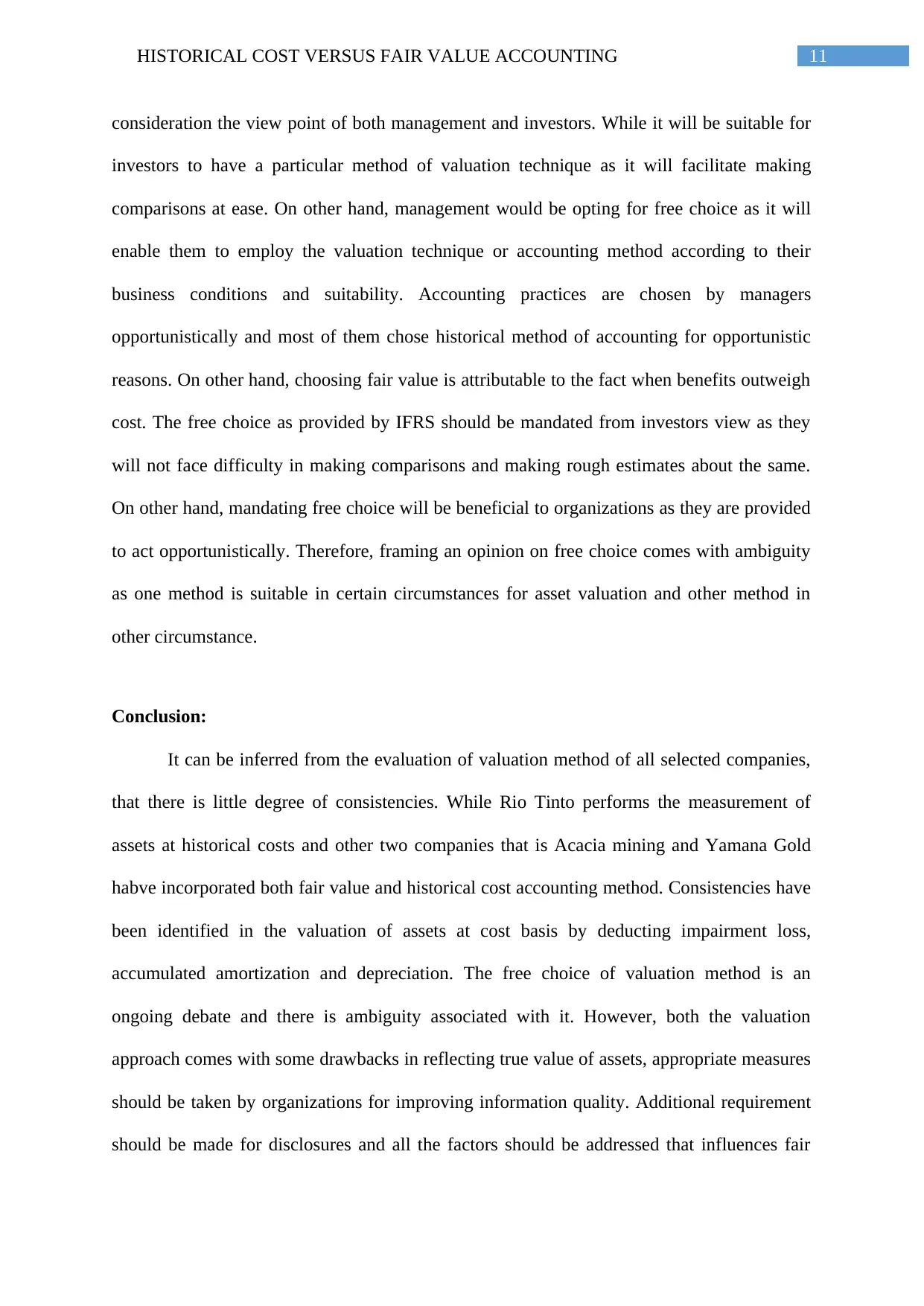
11HISTORICAL COST VERSUS FAIR VALUE ACCOUNTING
consideration the view point of both management and investors. While it will be suitable for
investors to have a particular method of valuation technique as it will facilitate making
comparisons at ease. On other hand, management would be opting for free choice as it will
enable them to employ the valuation technique or accounting method according to their
business conditions and suitability. Accounting practices are chosen by managers
opportunistically and most of them chose historical method of accounting for opportunistic
reasons. On other hand, choosing fair value is attributable to the fact when benefits outweigh
cost. The free choice as provided by IFRS should be mandated from investors view as they
will not face difficulty in making comparisons and making rough estimates about the same.
On other hand, mandating free choice will be beneficial to organizations as they are provided
to act opportunistically. Therefore, framing an opinion on free choice comes with ambiguity
as one method is suitable in certain circumstances for asset valuation and other method in
other circumstance.
Conclusion:
It can be inferred from the evaluation of valuation method of all selected companies,
that there is little degree of consistencies. While Rio Tinto performs the measurement of
assets at historical costs and other two companies that is Acacia mining and Yamana Gold
habve incorporated both fair value and historical cost accounting method. Consistencies have
been identified in the valuation of assets at cost basis by deducting impairment loss,
accumulated amortization and depreciation. The free choice of valuation method is an
ongoing debate and there is ambiguity associated with it. However, both the valuation
approach comes with some drawbacks in reflecting true value of assets, appropriate measures
should be taken by organizations for improving information quality. Additional requirement
should be made for disclosures and all the factors should be addressed that influences fair
consideration the view point of both management and investors. While it will be suitable for
investors to have a particular method of valuation technique as it will facilitate making
comparisons at ease. On other hand, management would be opting for free choice as it will
enable them to employ the valuation technique or accounting method according to their
business conditions and suitability. Accounting practices are chosen by managers
opportunistically and most of them chose historical method of accounting for opportunistic
reasons. On other hand, choosing fair value is attributable to the fact when benefits outweigh
cost. The free choice as provided by IFRS should be mandated from investors view as they
will not face difficulty in making comparisons and making rough estimates about the same.
On other hand, mandating free choice will be beneficial to organizations as they are provided
to act opportunistically. Therefore, framing an opinion on free choice comes with ambiguity
as one method is suitable in certain circumstances for asset valuation and other method in
other circumstance.
Conclusion:
It can be inferred from the evaluation of valuation method of all selected companies,
that there is little degree of consistencies. While Rio Tinto performs the measurement of
assets at historical costs and other two companies that is Acacia mining and Yamana Gold
habve incorporated both fair value and historical cost accounting method. Consistencies have
been identified in the valuation of assets at cost basis by deducting impairment loss,
accumulated amortization and depreciation. The free choice of valuation method is an
ongoing debate and there is ambiguity associated with it. However, both the valuation
approach comes with some drawbacks in reflecting true value of assets, appropriate measures
should be taken by organizations for improving information quality. Additional requirement
should be made for disclosures and all the factors should be addressed that influences fair
⊘ This is a preview!⊘
Do you want full access?
Subscribe today to unlock all pages.

Trusted by 1+ million students worldwide
1 out of 15
Related Documents
Your All-in-One AI-Powered Toolkit for Academic Success.
+13062052269
info@desklib.com
Available 24*7 on WhatsApp / Email
![[object Object]](/_next/static/media/star-bottom.7253800d.svg)
Unlock your academic potential
Copyright © 2020–2025 A2Z Services. All Rights Reserved. Developed and managed by ZUCOL.





